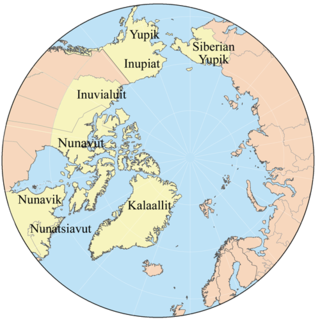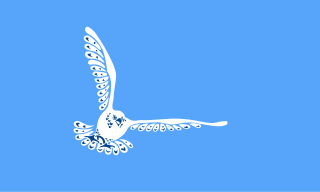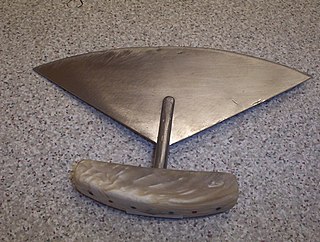Related Research Articles

Eskimo is an exonym that refers to two closely related Indigenous peoples: Inuit and the Yupik of eastern Siberia and Alaska. A related third group, the Aleut, who inhabit the Aleutian Islands, are generally excluded from the definition of Eskimo. The three groups share a relatively recent common ancestor, and speak related languages belonging to the Eskaleut language family.

The Inuit languages are a closely related group of indigenous American languages traditionally spoken across the North American Arctic and the adjacent subarctic regions as far south as Labrador. The Inuit languages are one of the two branches of the Eskimoan language family, the other being the Yupik languages, which are spoken in Alaska and the Russian Far East. Most Inuit people live in one of three countries: Greenland, a self-governing territory within the Kingdom of Denmark; Canada, specifically in Nunavut, the Inuvialuit Settlement Region of the Northwest Territories, the Nunavik region of Quebec, and the Nunatsiavut and NunatuKavut regions of Labrador; and the United States, specifically in northern and western Alaska.

The Eskaleut, Eskimo–Aleut or Inuit–Yupik–Unangan languages are a language family native to the northern portions of the North American continent, and a small part of northeastern Asia. Languages in the family are indigenous to parts of what are now the United States (Alaska); Canada including Nunavut, Northwest Territories, northern Quebec (Nunavik), and northern Labrador (Nunatsiavut); Greenland; and the Russian Far East. The language family is also known as Eskaleutian, Eskaleutic or Inuit–Yupik–Unangan.
Inuvialuktun comprises several Inuit language varieties spoken in the northern Northwest Territories by Canadian Inuit who call themselves Inuvialuit. Some dialects and sub-dialects are also spoken in Nunavut.

Inuinnaqtun, is an Inuit language. It is spoken in the central Canadian Arctic. It is related very closely to Inuktitut, and some scholars, such as Richard Condon, believe that Inuinnaqtun is more appropriately classified as a dialect of Inuktitut. The government of Nunavut recognises Inuinnaqtun as an official language in addition to Inuktitut, and together sometimes referred to as Inuktut. It is spoken in the Northwest Territories as well and is recognised as an official language of the territory in addition to Inuvialuktun and Inuktitut.

Inuktitut, also known as Eastern Canadian Inuktitut, is one of the principal Inuit languages of Canada. It is spoken in all areas north of the North American tree line, including parts of the provinces of Newfoundland and Labrador, Quebec, to some extent in northeastern Manitoba as well as the Northwest Territories and Nunavut. It is one of the aboriginal languages written with Canadian Aboriginal syllabics.

The Inuvialuit or Western Canadian Inuit are Inuit who live in the western Canadian Arctic region. They, like all other Inuit, are descendants of the Thule who migrated eastward from Alaska. Their homeland – the Inuvialuit Settlement Region – covers the Arctic Ocean coastline area from the Alaskan border, east through the Beaufort Sea and beyond the Amundsen Gulf which includes some of the western Canadian Arctic Islands, as well as the inland community of Aklavik and part of Yukon. The land was demarked in 1984 by the Inuvialuit Final Agreement.

An ulu is an all-purpose knife traditionally used by Inuit, Iñupiat, Yupik, and Aleut women. It is used in applications as diverse as skinning and cleaning animals, cutting a child's hair, cutting food, and sometimes even trimming blocks of snow and ice used to build an igloo.

Sallirmiutun is the dialect of Inuvialuktun spoken by the Siglit, an Inuit group of the Northwest Territories, Canada. It is mainly used in the Inuvialuit communities of Paulatuk, Sachs Harbour and Tuktoyaktuk. Sallirmiutun was once the principal dialect of the Mackenzie River delta, nearby parts of the coast and Arctic Ocean islands, but the number of speakers fell dramatically following outbreaks of new diseases in the 19th century and for many years Sallirmiutun was believed to be completely extinct. It was only in the 1980s that outsiders realised that it was still spoken.

Uummarmiutun, Uummaġmiutun or Canadian Iñupiaq is the variant of Iñupiaq spoken by the Uummarmiut, part of the Inuvialuit, who live mainly in the communities of Inuvik and Aklavik in the Northwest Territories of Canada.

Ulukhaktok and known until 1 April 2006 as Holman or Holman Island) is a small hamlet on the west coast of Victoria Island, in the Inuvik Region of the Northwest Territories, Canada.

Inuktun is the language of approximately 1,000 indigenous Inughuit, inhabiting the world's northernmost settlements in Qaanaaq and the surrounding villages in northwestern Greenland.

The Netsilik (Netsilingmiut) are Inuit who live predominantly in Kugaaruk and Gjoa Haven, and somewhat in Taloyoak of the Kitikmeot Region, Nunavut, and, to a smaller extent in the north Qikiqtaaluk Region, in Canada. They were, in the early 20th century, among the last northern indigenous peoples to encounter missionaries from the south.

Copper Inuit, also known as Inuinnait and Kitlinermiut, are a Canadian Inuit group who live north of the tree line, in what is now the Kitikmeot Region of Nunavut and in the Inuvialuit Settlement Region in the Inuvik Region of the Northwest Territories. Most of them historically lived in the area around Coronation Gulf, on Victoria Island, and southern Banks Island.

The Kangiryuarmiut are an Inuvialuit group, culturally and historically related to the Copper Inuit. They were historically located on Victoria Island in the areas of Prince Albert Sound, Cape Baring, and central Victoria island. They often travelled seasonally around their traditional territory including to Banks Island, both south to Nelson Head and as far north as Mercy Bay to collect raw materials from the wreck of HMS Investigator. Archaeologists have also found many sites left by Kangiryuarmiut and their ancestors in what is now Aulavik National Park. Today, many Kangiryurmiut still live on Victoria Island, in the hamlet of Uluhaktok, now within the Inuvialuit Settlement Region.

The Inuvialuit Settlement Region, abbreviated as ISR, located in Canada's western Arctic, was designated in 1984 in the Inuvialuit Final Agreement by the Government of Canada for the Inuvialuit people. It spans 90,650 km2 (35,000 sq mi) of land, mostly above the tree line, and includes several subregions: the Beaufort Sea, the Mackenzie River delta, the northern portion of Yukon, and the northwest portion of the Northwest Territories. The ISR includes both Crown Lands and Inuvialuit Private Lands.

Snow goggles are a type of eyewear traditionally used by the Inuit and the Yupik peoples of the Arctic to prevent snow blindness.
Fort Collinson was a trading post operated by the Hudson's Bay Company located on Victoria Island in the Northwest Territories, Canada. It is situated on the Prince Albert Peninsula on the north side of Walker Bay, just north of Minto Inlet.

Inuit Nunangat refers to the land, water, and ice of the homeland of Inuit in Canada. This Arctic homeland consists of four northern Canadian regions called the Inuvialuit Settlement Region, the territory Nunavut (ᓄᓇᕗᑦ), Nunavik (ᓄᓇᕕᒃ) in northern Quebec, and Nunatsiavut of Newfoundland and Labrador.
Utkuhiksalik, Utkuhikhalik, Utkuhikhaliq, Utkuhiksalingmiutitut, Utkuhiksalingmiutut, Utkuhiksalingmiut Inuktitut, Utku, Gjoa Haven dialect, is a sub-dialect of Natsilingmiutut (Nattiliŋmiut) dialect of Inuvialuktun language once spoken in the Utkuhiksalik area of Nunavut, and now spoken mainly by elders in Uqsuqtuuq and Qamani'tuaq on mainland Canada. It is generally written in Inuktitut syllabics.
References
- ↑ Olokhaktomiut Community Conservation Plan, July 2008 Archived 2011-07-06 at the Wayback Machine
- ↑ Inuinnaqtun to English, Nunavut Arctic College